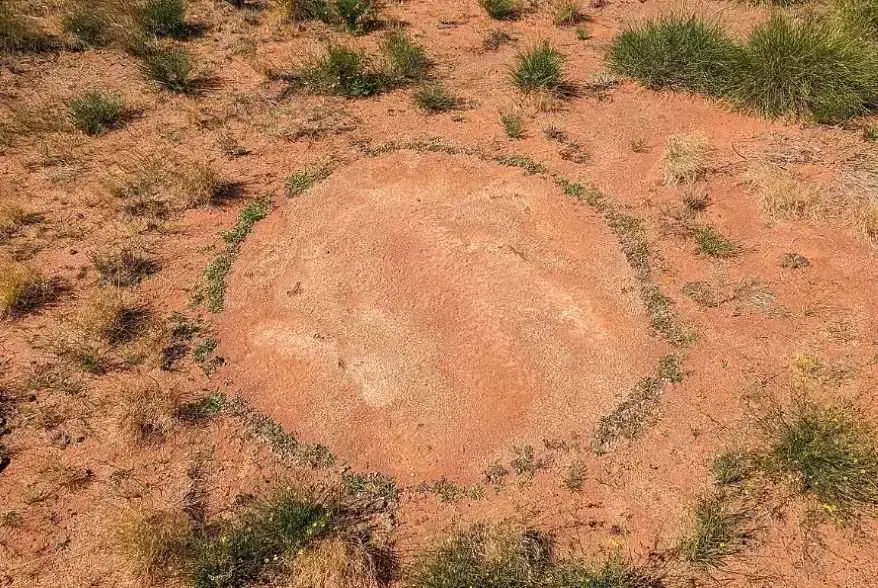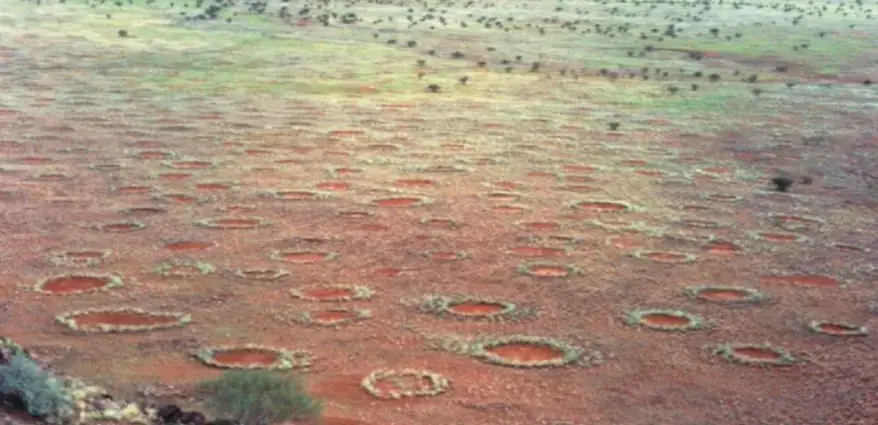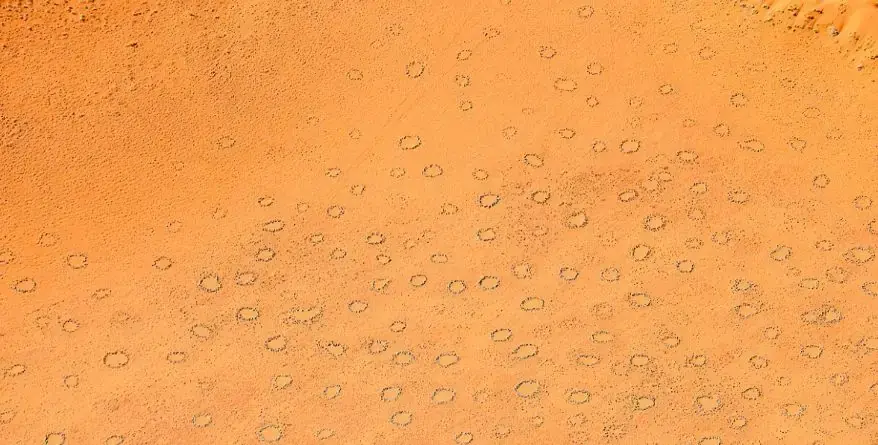The Mystery of Fairy Circles: Nature’s Unique Phenomenon
Fairy circles are one of nature’s most intriguing phenomena, captivating ecologists, researchers, and tourists alike. These are enigmatic circular patches surrounded by taller grasses. They are predominantly found in the arid grasslands of southwestern Africa, particularly Namibia. Similar formations have also been reported in Australia and other regions. This has led to sparking debates about their origins and ecological significance.

What Are Fairy Circles?
They are barren patches in grasslands that exhibit a strikingly regular spatial pattern. In Namibia, these circles range from 4 to 10 meters in diameter. Also, these are surrounded by a ring of taller grasses than the surrounding matrix. They occur in areas receiving 50–150 mm of annual rainfall. They are typically found on coarse aeolian sands. These formations are highly regular in their dispersion, with a spacing between adjacent circles of around 10 meters.
The longevity of fairy circles adds to their mystique—some persist for decades or centuries. For example, aerial photographs from 1956 compared with 2006 satellite images showed that many fairy circles remained intact over 50 years despite some changes. However, their lifespan can be dynamic; during droughts, they may become invisible but reappear under favorable conditions.
Hypotheses Explaining Fairy Circle Formation
The origins of fairy circles have been a subject of heated debate among scientists. Several hypotheses have emerged over the years:
1. Termite Origin (TO) Hypothesis–
This hypothesis attributes fairy circle formation to the activities of Psammotermes allocerus termites. These termites create barren patches through their foraging and nest-building behaviors, which result in circular formations. The spacing between fairy circles is believed to arise from competitive interactions between termite colonies.
Challenges:
- Termite colonies are not consistently located at the center of fairy circles.
- The long-term stability of fairy circles does not align well with termite population dynamics.
- There is limited evidence for aggressive interactions between termite colonies at the scale required to produce such patterns.
2. Vegetation Self-Organization (VSO) Hypothesis–
The VSO hypothesis suggests that fairy circles result from self-organizing processes among plants competing for scarce water resources. Neighboring plants create barren patches as they vie for water. Thus, leading to the characteristic circular formations with grassy peripheries.
Challenges:
- The hypothesis lacks direct empirical evidence regarding underground water and nutrient fluxes.
- The precise mechanisms driving self-organization remain unclear.
3. Other Hypotheses
- Gaseous Emissions: Proposes that soil gases cause grass death within fairy circles. However, this lacks supporting evidence.
- Allelopathy: Suggests that toxic compounds from certain plants, like Euphorbia species, lead to vegetation gaps. While plausible in some cases, this theory does not account for all observed patterns.
- Microbial Activity: Differences in microbial communities inside and outside these circles may influence plant health, but require further study.
Characteristics That Define Fairy Circles

Circles exhibit several unique features that set them apart from other ecological phenomena:
- Circular Shape: These circles are almost perfectly round.
- Peripheral Grasses: Taller grasses often form a ring around the barren patch.
- Regular Spacing: The circles are highly regular in their distribution across the landscape.
- Sandy Soils: They occur predominantly on coarse aeolian sands.
- Longevity: Many circles persist for decades or even centuries.
- Water Retention: The barren patches retain more soil moisture after rainfall than the surrounding areas.
These characteristics make these circles one of the most striking examples of spatial patterning in nature.
Ecological Significance of Fairy Circles
The circles contribute significantly to landscape heterogeneity in arid regions. The barren patches retain more soil moisture after rainfall than the surrounding areas. Hence, creating microhabitats that support diverse flora, fauna, and microbial life. This emergent heterogeneity enhances ecological stability and resilience in these harsh environments.
From an ecological perspective, fairy circles represent a fascinating example of niche construction. Whether by termites or plants, this alters resource distribution and impacts ecosystem dynamics. Understanding these processes could provide insights into how organisms adapt to resource scarcity and environmental stress.
Global Occurrence: Are Fairy Circles Unique?

While Namibia is home to the most iconic examples of fairy circles, similar patterns have been observed elsewhere:
- Australia: Smaller but similarly periodic barren patches have been identified as fairy circles.
- Other Regions: Satellite imagery has revealed “fairy circle-like” patterns at over 260 sites across 15 countries on three continents. These formations share some characteristics with Namibian circles but lack their extreme regularity.
Interestingly, researchers have also reported features resembling these circles in marine environments (e.g., seagrass meadows) and salt marshes. However, these occurrences involve different mechanisms. These raise questions about whether the term “fairy circle” should be reserved for terrestrial formations like those in Namibia.
Future Directions: Resolving the Mystery
Despite decades of research, the mechanisms driving fairy circle formation remain elusive. Progress will require:
- Manipulative Experiments: Testing hypotheses by altering environmental factors. For example, termite presence, soil nutrients, and water availability.
- Long-Term Monitoring: Observing changes in the circle development under varying climatic conditions.
- Global Comparisons: Need to conduct fieldwork at sites with “fairy circle-like” patterns. Further, to determine whether they share common mechanisms or represent distinct phenomena.
Advances in remote sensing technologies and computational modeling could also help unravel this mystery. Additionally, they can do this by analyzing spatial patterns across diverse landscapes.
Conclusion: Nature’s Puzzle Continues
Fairy circles are more than just a scientific curiosity. They are a testament to nature’s complexity and ingenuity in adapting to extreme environments. Whether formed by termites engineering their habitat or plants self-organizing under resource constraints. These enigmatic patterns challenge our understanding of ecological processes.
As research continues, the circles will undoubtedly remain a focal point for ecologists seeking answers about how life thrives against the odds. For now, they stand as one of nature’s most beautiful puzzles. They remind us that even in barren landscapes, life finds a way to create order amidst chaos.
Reference
- Cramer, M. D., & Tschinkel, W. R. (2025). Fairy circle research: Status, controversies and the way forward. Perspectives in Plant Ecology Evolution and Systematics, 125851. https://doi.org/10.1016/j.ppees.2025.125851
Additionally, to stay updated with the latest developments in STEM research, visit ENTECH Online. Basically, this is our digital magazine for science, technology, engineering, and mathematics. Further, at ENTECH Online, you’ll find a wealth of information.






